Recogniform Image Quality Control and Usability Assurance
 info
info
Our software allows to evaluate automatically image quality and usability measuring image quality defects and/or deviations from the ideal perfect image using state of art technical measurements not requiring any human subjective judgments.
Some of common image quality defects are: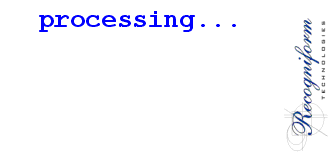
The system performs quantitative measures of images attributes (e.g. “image skew”) and a
qualitative assertion about the presence of a defect (e.g. “excessive document
skew”) using user-defined thresholding parameters (e.g. "minimum and maximum skew
angle allowed") that strike an effective and practical balance between correctly
identifying defects that might affect usability (avoiding “escapes”) and
incorrectly identifying defects that won’t affect usability (“false positives”).
Once the
defect is determined, it will be possible to “repair” the defect without
re-scan using Image Processing tecnique (deskew, despeckle, black border
removal, dynamic thresholding, etc.), or by a new scanning action: this last option is strictly
necessary when the image lost a portion of its content, as caused by improper
positioning/feeding on scanner device.
Some of possible business impacts of
image quality defects are:
-
Missing information due to
missing/obscured key data fields.
-
Financial losses due to
document re-scan (work flow and labor expense impact).
-
-
Esthetic artifacts with the document image that could create issues for image print
applications.
-
Legibility and usability problems.
-
No information on the
piggybacked item (item behind).
-
Potential losses due to lost
information.
Common Image
Defects Overview:
1. Undersize Image
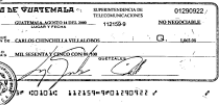 This defect is due to the document image rendition’s width or height being below the minimum image size based on the minimum image size and tolerances associated with the image capture platform.
This defect is due to the document image rendition’s width or height being below the minimum image size based on the minimum image size and tolerances associated with the image capture platform.
Condition:
- Image width/height < minimum user-defined width/height threshold.
This defect can develop in case of:
torn document (a significant portion of the original source document is absent);
folded document (a significant portion of the original source document is folded);
improperly framed document (the
leading or trailing edge of the document has been truncated due to a camera synchronization error during the image capture process).
2. Folded or Torn Document Corners
This defect is due to the corner of the source document being either missing and/or folded in the document image
rendition.
Condition:
- Fold/tear corner width/height > Maximum fold/tear corner width/height threshold.
Independent fold/tear corner
width and height thresholds will be defined for each corner of the document,
i.e., four separate sets of width and height thresholds.
This defect can develop in case of:
- Folded document corners (a corner of the source document has been folded, causing an area of the document image to be
missing and obscured).
3. Folded or Torn Document Edges
This defect is due to the edge of the source document being either missing and/or folded in the document image
rendition.
Condition:
- Folded/torn edge width > Maximum edge fold/tear width threshold
and
- Folded/torn edge height > Maximum edge fold/tear height threshold
Independent folded/torn edge
width and height thresholds will be defined for each edge of the document,
i.e., four separate sets of width and height thresholds.
This defect can develop in case of torn and/or folded document edge (an edge of the source document has been torn and/or
folded, causing an area of the document image to be missing and obscured).
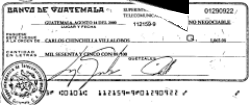
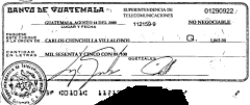
Top of the page
4. Document Framing Error
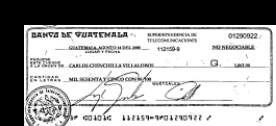 This defect is due to the inclusion of additional vertical and/or horizontal scan lines, withinthe document image, that contain no document pixel data.
This defect is due to the inclusion of additional vertical and/or horizontal scan lines, withinthe document image, that contain no document pixel data.
Condition:
- Width of additional left/right/top/bottom edge
scan lines > Maximum left/right/top/bottom edge over scan threshold
This defect can develop in case of:
Presence of additional scan lines prior to the left (or prior to the right) edge
of the document in the document image.
Presence of additional scan lines below the bottom (or above the top) edge of the document in the document image.
These conditions can be the result of the image camera system not being able to properly detect the edges of the document during the image capture process.
Top of the page
5. Excessive Document Skew
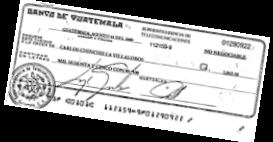 This defect is caused by the image document not being in proper alignment with the image camera sensor.
This defect is caused by the image document not being in proper alignment with the image camera sensor.
Condition:
- Document Skew Angle
< Negative Skew Angle Threshold
or
- Document Skew Angle
> Positive Skew Angle Threshold
This defect can appear in case of:
Top of the page
6. Oversize Image
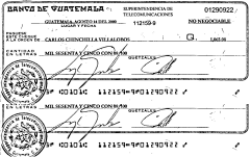 This defect is due to the document
image rendition’s width or height being above the maximum image size based on a
maximum image size and tolerances associated with the image capture platform.
This defect is due to the document
image rendition’s width or height being above the maximum image size based on a
maximum image size and tolerances associated with the image capture platform.
Condition:
- Image width/height > Maximum
image width/height threshold
It may verify in case of:
-
Overlapped (piggy-backed)
documents. An image containing two or more documents that are overlapped as
they pass the image camera.
-
Under-spaced documents. An
image containing two or more documents that are separated by only a small
distance (or end-to-end), resulting in two documents being captured as a single
image.
-
Skewed documents. Excessively
skewed documents may cause the maximum image height to be exceeded.
Top of the page
7. Piggyback Document
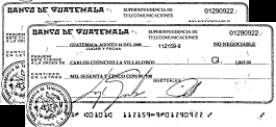 A piggy-back image defectoccurs when two or more documents are present and overlapped within the
document image.
A piggy-back image defectoccurs when two or more documents are present and overlapped within the
document image.
It may be identified by:
- Document images with more than one document.
- Detected multiple document
heights within the document image.
This defect is generally due to:
- Poor document quality.
- Poor document work preparation/sorting.
- Mechanical handling and
control problems within the document transport feeder or track.
Top of the page
8. Image Too Light
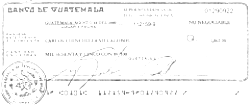 For a bi-tonal image, the defect is due to a insufficient number of “black” pixels.
For a bi-tonal image, the defect is due to a insufficient number of “black” pixels.
For a gray level image, the defect is due to high “brightness“ and low
“contrast”.
Condition for Bi-tonal Images:
- Percentage of black
pixels < Minimum percentage of black pixels threshold.
Condition for Gray Level and Color Images:
- % Average Brightness> Maximum percent brightness threshold
and
- % Average Contrast
< Minimum percent contrast threshold
This defect can be due to one
or more of the following problems:
- Poor printing/writing
contrast on the source document.
- Improper thresholding of the
document background.
- Illumination problems with
the image capture subsystem.
Top of the page
9. Image Too Dark
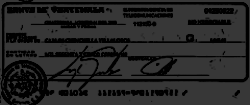 For a bi-tonal image, this defect is due to the image having too many “black” pixels.
For a bi-tonal image, this defect is due to the image having too many “black” pixels.
For a gray level image,
this defect is due to the image having insufficient “brightness“.
Condition for Bi-tonal Images:
- % of black
pixels > Maximum % of Black Pixels Threshold.
Condition for Gray Level and Color Images:
- % Average Brightness
< Minimum % Brightness Threshold
This defect could be an
indicator of one of the following problems:
- Excessive printing/writing on
the source document.
- Improper thresholding of the
document background.
- Large amounts of black pixel
“noise” present in the image.
- Illumination problems with
the image capture subsystem.
- Image camera calibration
problems.
Top of the page
10. Horizontal Streaks Present in the Image
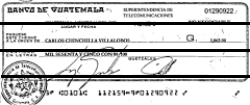 A defect due to the imagecontaining one or more “dark” (for all images) or “light” (for gray level and
color images) horizontal streaks that extend horizontally across the majority
of the entire document image.
A defect due to the imagecontaining one or more “dark” (for all images) or “light” (for gray level and
color images) horizontal streaks that extend horizontally across the majority
of the entire document image.
Condition for Bi-tonal Images:
- Largest black streak
height > Maximum Black Streak Height Threshold
- Number of black
streaks > Maximum Black Streak Count Threshold
Condition for Gray Level and Color Images:
- Largest gray level
streak height > Maximum Gray Level Streak Height Threshold
- Number of gray level streaks > Maximum Gray Level Streak Count Threshold
Dark streaks can be
caused by a number of factors during the image capture process. Possible
sources of dark streaks include the following:
- Dirt and/or ink that
can adhere to either the image capture scan window or camera lens commonly
present in most high, medium or low-speed document transport imaging systems.
- A scratch or irregularity
present on the image scan window or camera lens – top or bottom.
- Dirt or debris on camera
calibration targets, i.e., white reference targets.
- Failure of the image camera
CCD sensor or electronics.
Top of the page
11. Below Minimum Compressed Image Size
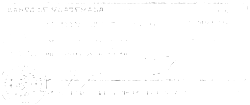 The compressed image size istoo low.
The compressed image size istoo low.
Condition for bi-tonal images:
- Compressed Image Size <
Minimum Bi-tonal Compressed Image Size Threshold
Condition for gray level and color images:
- Compressed Image Size <
Minimum Gray Level Compressed Image Size Threshold
Minimum compressed image size
thresholds will be independently established for the front and rear image of
the document and will be dependent on the image compression method utilized.
This defect could be an
indicator of one of the following problems:
- Improper suppression
(thresholding) of the document background.
- Image camera calibration
problems.
- Inappropriate compression parameters/settings, yielding an image with a high level of
distortion.
- A white document with very
little writing or printing, e.g., the rear of a image with a small endorsement.
Top of the page
12. Above Maximum Compressed Image Size
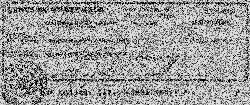 The compressed image size is too high.
The compressed image size is too high.
Condition for bi-tonal images:
Compressed Image Size >Maximum Bi-tonal Compressed Image Size Threshold
Condition for gray level and color images:
Compressed Image Size >
Maximum Gray Level Compressed Image Size Threshold
Maximum compressed image size
thresholds will be independently established for the front and rear image of
the document and will be dependent on the image compression method utilized.
A large compressed image
packet size is generally an indicator of a
image with a high information content, e.g., lots of writing or printing
or high contrast background patterns.
In the case of a bi-tonal
image rendition, a large compressed image packet size occurs when the image contains a lot of black/white pixel transitions. This could be an indicator that the bi-tonal image has the following attributes:
- a significant amount of image
“noise” present in the image;
- a large amount of written/printed
data present in the image;
- a significant amount of the
image background pattern/scene has been retained during the creation of the
bi-tonal rendition.
Top of the page
13. Excessive “Spot Noise” in the Image
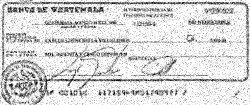 Spot noise is an image defect due to image containing “excessive occurrences” (greater than some defined
count) of “spot noise” (isolated dark small pixel groups).
Spot noise is an image defect due to image containing “excessive occurrences” (greater than some defined
count) of “spot noise” (isolated dark small pixel groups).
Condition:
- Average spot noise count per 1 sq.inch area > Maximum spot
noise count threshold.
Noise can be caused by one or more of factors:
- The scanned document may have a “cluttered” background such as a complex high contrast image. When imaged and
thresholded, this type of background can result in many small dark regions or
noise.
- Noise can result from a
document that has very low contrast. In this case the threshold algorithm may
produce many isolated dark regions as it struggles to differentiate between
what is dark and what is bright. This can happen if the original grayscale image
is bright or dark.
- Low contrast and subsequent
noise can also occur if there is a problem with the scanning system such as
improper illumination.
- Noise could be the result of
physical defects on the document being scanned.
Top of the page
14. Front-Rear Image Dimension Mismatch
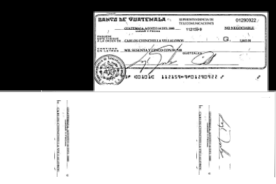 This type of defect indicates that the image height and width do not match between the front and rear images
of the source document.
This type of defect indicates that the image height and width do not match between the front and rear images
of the source document.
Condition:
Absolute value of the image
width/heigth difference > Maximum image width/height difference.
This defect may verify in case of:
- The front image of
document “n” being matched up with the rear image of document “n-1”.
- Differences in
document framing for the front and rear image renditions of the document.
Top of the page
15. Carbon Strip Detected (cheques only)
 A defect due to the presenceof a “carbonized band”, that typically extends from the leading edge to
trailing edge on the rear of the image, that can potentially interfere with the
legibility of endorsements.
A defect due to the presenceof a “carbonized band”, that typically extends from the leading edge to
trailing edge on the rear of the image, that can potentially interfere with the
legibility of endorsements.
Condition:
- A black band is present on the rear of the document image that meets the size and location requirements
for a carbonized band.
- The black band height exceeds the Minimum Carbon Strip Height parameter setting.
This defect is generally due to:
Top of the page
16. Image “Out of Focus”
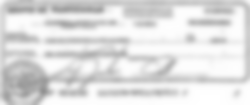 An image defect due to theimage camera subsystem being “out of focus” resulting in blurred image
renditions of the document.
An image defect due to theimage camera subsystem being “out of focus” resulting in blurred image
renditions of the document.
Condition: Image Focus Score < Minimum Focus Threshold
Top of the page
Price & Ordering Info
For price and ordering information please contact us.
Evaluation Version
Recogniform Image Quality Control and Usability Assurance system is available as SDK for integration in own application or as full ready-to-use batch processing application.
Please contact us to get an evaluation version.
More Info
If you need further information about this product, please use the contacts page.
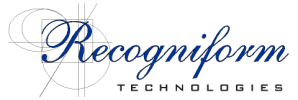


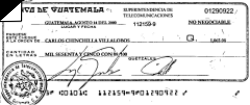
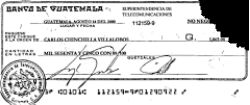











 Spot noise is a
Spot noise is a

